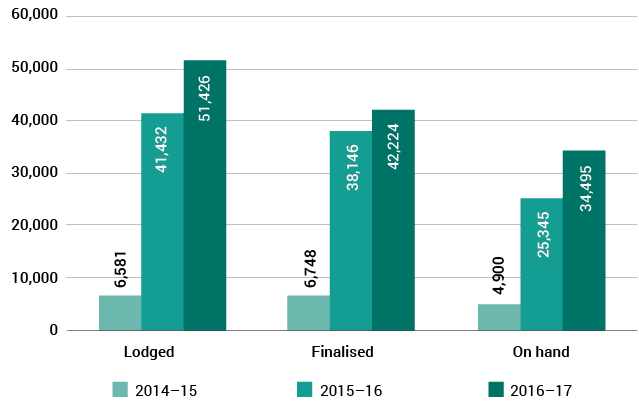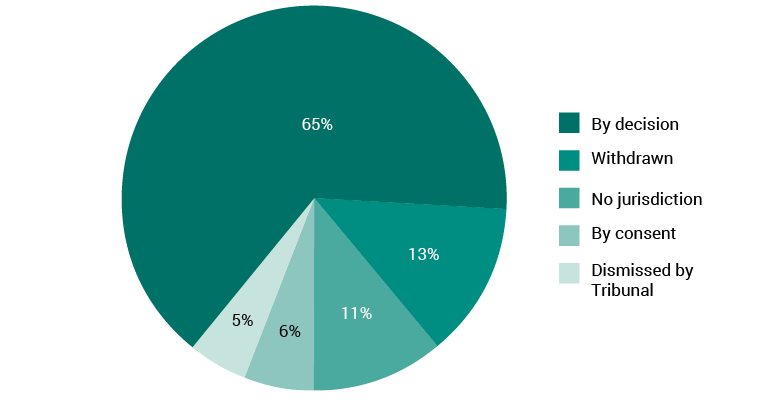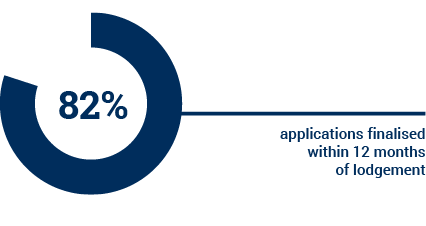The Administrative Appeals Tribunal (AAT) conducts independent reviews of administrative decisions made under Commonwealth laws. We review decisions made by Australian Government ministers, departments and agencies and, in limited circumstances, decisions made by state and territory government and non-government bodies.
The AAT was established by the Administrative Appeals Tribunal Act 1975 and commenced operations on 1 July 1976. On 1 July 2015, the Migration Review Tribunal (MRT), Refugee Review Tribunal (RRT) and Social Security Appeals Tribunal (SSAT) were amalgamated with the AAT.
The AAT consists of the President who is a judge of the Federal Court of Australia and the other members who may be appointed as Deputy Presidents, Senior Members and Members. The Registrar and staff assist the AAT to carry out our functions.
Applications to the AAT are managed in one of eight divisions:
- Freedom of Information Division
- General Division
- Migration and Refugee Division
- National Disability Insurance Scheme Division
- Security Division
- Social Services and Child Support Division
- Taxation and Commercial Division, and
- Veterans’ Appeals Division.
We can review decisions made under more than 400 laws. The types of decisions we most commonly review relate to:
- child support
- family assistance and social security
- migration and refugee visas
- taxation
- veterans’ entitlements, and
- workers’ compensation under Commonwealth laws.
We also review a wide range of other decisions, such as decisions about Australian citizenship, bankruptcy, civil aviation, corporations and financial services regulation, customs, freedom of information, the National Disability Insurance Scheme, paid parental leave, passports, and security assessments by the Australian Security Intelligence Organisation.
When we review a decision, we take a fresh look at the facts, law and policy relating to the decision. We consider all the material before us and decide what is the correct or preferable decision in the case.
Key caseload statistics
The AAT received 51,426 applications and finalised 42,224 applications in 2016–17. There were 34,495 applications on hand at 30 June 2017.
The number of applications lodged with the AAT increased by 24 per cent during 2016–17. While the number of applications finalised rose by 11 per cent, the significant increase in lodgements resulted in a 36 per cent increase in the number of applications on hand at year end.
Caseload overview, 2014–15 to 2016–17

The size of the AAT’s caseload varies significantly between divisions as shown in the following table.
Lodgements, finalisations and cases on hand, 2016–17 – By division
| DIVISION |
Lodgements |
% of totala |
Finalisations |
% of totala |
On hand |
% of totala |
| Freedom of Information |
44 |
<1% |
37 |
<1% |
66 |
<1% |
| General |
5,798 |
11% |
5,414 |
13% |
3,909 |
11% |
| Migration and Refugee |
26,604 |
52% |
18,908 |
45% |
24,462 |
71% |
| National Disability Insurance Scheme |
215 |
<1% |
89 |
<1% |
151 |
<1% |
| Security |
10 |
<1% |
10 |
<1% |
11 |
<1% |
| Social Services and Child Support |
17,450 |
34% |
16,407 |
39% |
4,320 |
13% |
| Taxation and Commercial |
975 |
2% |
1,051 |
2% |
1,222 |
4% |
| Veterans’ Appeals |
330 |
<1% |
308 |
<1% |
354 |
1% |
| TOTAL |
51,426 |
100% |
42,224 |
100% |
34,495 |
100% |
aPercentages may not total 100% due to rounding.
Our review processes vary according to the type of decision we are reviewing. These differences reflect legislative requirements as well as particular strategies we use to manage the broad range of decisions we can review. Our procedures are designed to give an applicant and any other party to a review a reasonable opportunity to present their case.
A key feature of merits review is the opportunity for the applicant and any other party to give us new information that was not available to the original decision-maker. At different stages of the review process, we may invite or direct a party to give us information that will be relevant to the case.
In some types of reviews, we hold conferences or directions hearings to talk to the parties about the issues and give directions about what the parties must do and by when to progress the case. When a review involves more than one party, we help them try to reach an agreed outcome without the need for a hearing while ensuring steps are taken to prepare for a hearing in the event it cannot be resolved by agreement. As well as conferences, we use other types of alternative dispute resolution processes to try to resolve cases by agreement. In some types of reviews, the case is listed directly for a hearing.
Applications made to the AAT may be finalised in different ways. In 2016–17, the majority of applications were finalised by the Tribunal making a decision on the review, generally after conducting a hearing but on the papers in certain circumstances. In six per cent of finalised cases, the reviewable decision was either affirmed, varied or set aside in accordance with an agreement reached between the parties. The remainder of the applications were withdrawn by the applicant, finalised on the basis that they did not meet the requirements for a valid application, or otherwise dismissed without the Tribunal reviewing the decision.
The AAT changed the decision under review in 26 per cent of all applications finalised in 2016–17 compared with 28 per cent in 2015–16. Decisions are commonly changed because of the new information that was available to the Tribunal. A change in the applicant’s circumstances since the time of the original decision can also be relevant. Taking all of the evidence before us into account, the Tribunal may reach different conclusions when we apply the law and make a decision.
Number of alternative dispute resolution processes, directions hearings and hearings, 2014–15 to 2016–17
| EVENT TYPE |
2014–15 |
2015–16 |
2016–17 |
| Alternative dispute resolution processes (conferences, conciliations, case appraisals, mediations and neutral evaluations) |
8,321 |
8,636 |
8,826 |
| Directions hearings |
1,721 |
2,788 |
2,669 |
| Hearings |
1,183 |
24,856 |
26,638 |
Mode of finalisation of applications for review of decisions, 2016–17a

a ‘Dismissed by Tribunal’ includes applications dismissed by consent, for failure to appear before the Tribunal, for failure to proceed with an application or to comply with a direction of the AAT or on the basis that the application is frivolous, vexatious, misconceived, lacking in substance, has no reasonable prospect of success or is an abuse of the process of the AAT. ‘No jurisdiction’ includes applications finalised on the basis that the decision is not subject to review by the AAT, the applicant does not have standing to apply for a review, the application has not been made within a prescribed time limit, the AAT has refused to extend the time for applying for a review or the application fee has not been paid.
Performance
Timeliness
The AAT aims to finalise 75 per cent of applications within 12 months of lodgement. In 2016–17 we exceeded this target by seven percentage points. This is an improvement on the 80 per cent result achieved in 2015–16.

Judicial review outcomes
The AAT aims to have less than five per cent of all decisions that could have been appealed overturned by the courts. The number of appeals allowed by the courts in 2016–17 amounted to three per cent of all decisions made by the AAT in 2015–16 that could have been appealed to the courts. This is an improvement on the 3.3 per cent result in 2015–16.

Key achievements in 2016–17
Members and staff worked together successfully in 2016–17 to increase the number of cases finalised, giving tens of thousands of individuals and organisations the opportunity to challenge decisions that affected their interests. At the same time, we built on the work of the previous year, taking further steps to create an integrated AAT following amalgamation with the MRT, RRT and SSAT in July 2015.
We undertook various projects during 2016–17 aimed at improving the way cases are managed to increase efficiency and support the effectiveness of the review process. Trials in different types of cases explored the use of triage, outreach and different review pathways to progress cases and, in appropriate circumstances, finalise cases without the need for a hearing.
We are committed to providing review processes that are accessible to the wide range of people who are involved in cases at the AAT, particularly those who represent themselves. New video guides to be launched in the first quarter of 2017–18 were developed to assist our users to better understand our review processes. We also established an internal Accessibility Advisory Group to provide a cohesive and strategic approach to reviewing and making improvements to the accessibility of our services.
We adopted our digital strategy during the reporting period which provides a high-level roadmap for the delivery of a series of digital initiatives to improve how cases are managed for internal and external users and to foster greater information sharing across the AAT. In accordance with the strategy, we made substantial progress in developing a more intuitive and integrated website which will be launched in the first half of 2017–18 and worked on the development of a single online lodgement solution. We also continued to make improvements to other systems, undertaking further work on consolidating our information and communications technology infrastructure as well as improving our human resources systems.
In relation to our accommodation, the AAT made further headway on our program to bring together the multiple offices we inherited in each state capital city on 1 July 2015. In the reporting period, the AAT moved to a single location in Adelaide and Perth and made significant progress towards co-locating our offices in Brisbane and Melbourne. The consolidation of our accommodation across Australia will be complete by the end of 2017.
We continued to take steps in 2016–17 to break down silos between the Tribunal’s different divisions, improve consistency across divisions and increase our flexibility to utilise member and staff skills as effectively as possible. Many members of the Tribunal are now cross-assigned to more than one of the Tribunal’s divisions. In pursuit of our goal of transitioning over time to a single, integrated registry to support the review process, we implemented a revised senior executive structure, moving from three Division Registrars to two Executive Directors with functional responsibility for Registry Operations and Review Support. We commissioned a review of our current registry environment which identified a set of proposals for transitioning to more integrated services, and commenced the detailed mapping of registry processes to inform future steps.
The AAT maintained our strong commitment to developing our members and staff in 2016–17. We reached a further milestone in the implementation of our comprehensive member professional development program for the amalgamated AAT with the launch of the member appraisal scheme in August 2016. We also introduced the Workforce Development Plan 2016–20 which sets out six initiatives designed to improve the capabilities of our staff together with a new online performance appraisal system and appraisal policy. After a lengthy period of negotiations, the AAT’s new enterprise agreement for staff entered into force in June 2017.
More detailed information about the AAT and our operations is set out in our 2016–17 Annual Report which is available on our website at http://www.aat.gov.au/about-the-aat/corporate-information/annual-reports.